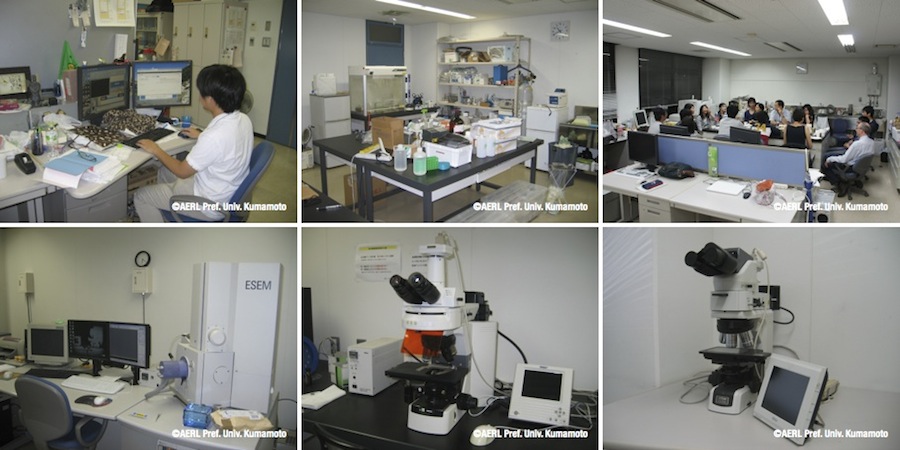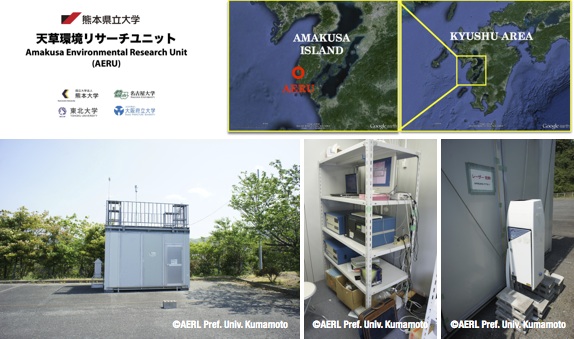Introduction of AERL
History
Atmospheric Environment Research Laboratory (Professor Zhang's group) was founded when the Faculty of Environmental and Symbiotic Sciences started in April 1999. Our group is now attacking atmospheric environmental problems in East Asia from different aspects of such as physics, chemistry and biology.
Current research topics
- Electoron microscopy for individual aerosol particle
- In order to explore and eveluate the effects of aerosol particles on climate and ecosystems, we have applied elecrtron microscopy to analyse individual aerosol particles. This is one of striking unique technique of our group and has contributed greatly to the series of our studies for air pollution and physicochamical cycles of dust particels.
- Measurement and analysis of air pollutants and meteorological factors
- We want to reveal the cause and mechanisms of long-range transport of air pollutants such as photochemical oxidants with careful investigation of relations between air quality and meteorological evolution. We set an observation site in Amakusa, the western coast of Kyushu island, to monitor air pollutants transported from Asian continent.
- Development of methods for detecting and analysing bioaerosols and application them to observations
- Bioaerosols are reffered as biologically originated aerosol particles. Although there is growing interest in the effects of bioaerosols on climate, ecosystems and health, the fundamental data are still scarse because of the lack of appreciate methods for monitoring such as bacterial cell concentration. We are attacking these problems and exploring the roles of bioaerosols in the environment.
We previsouly had studied chemical and physical cycles of air and sea by computer simulations.
You can see the variety of our research themes at previsous theses for degrees.

Left: Collection of airborne particles in Tibetan Plateau, middle: Observation with a tethered balloon, right: The interior of Amakusa Environmental Research Unit (AERU)

Left: sulfate particle, middle: ammonium sulfate particle, right: soot particle
Equipments
Our lab possesses a electron microscope, fluorescent microscope, clean bench for microbiological experiments and etc. Taking advantages of these various equiments, we are able to conduct unique research from different aspects.

Amakusa Environmental Research Unit (AERU)
We set up an observation unit called Amakusa Environmental Research Unit (AERU) in Amakusa (the west coast of Kyushu island) to monitor air quality and long-range transport of gaseous and particulate matters. Amakusa is suitable for atmospheric observation because of few sources of air pollutants and sufficiently distant from populated areas. AERU aim to be a comprehensive observation unit in a high time resolution for East Asian atmospheric environment. We collaborate with many research groups on monitoring gases, aerosols and radiation. The current instruments and targets are as following.

Upper: the location of AERU and collaborating groups
Lower left: the appearance of AERU. lower middle: A series of gas analyzers and nephelometer, lower right: a ceilometer CK25K
Instruments in AERL
- Weather Transmitter (WXT520, Vaisala)
- used to measure temperture, relative humidity, atmospheric pressure, precipitation, wind velocity and direion.
- Optical Particle Counter (KC-01E and KC22-B, RION)
- used for monitoring number concentration of airborne particles in five size ranges of >0.3, >0.5, >1.0, >2.0 and >5.0 um.
- Ceilometer (CT25K, Vaisala)
- used to estimate aerosol plume height and density (from Prof. Shibata's group in Nagoya University).
- Gas analyzers (model 42C, model 43X and model 49C, Thermo Fisher Scientific)
- used to analyze NOx, SO2 and ozone, respectively.
- Nitrate analyzer (Model 42C, Thermo Fisher Scientific)
- used for monitoring particulate nitrate, which was modified from gas analyzer 42C by Prof. Bandow's group in Osaka Prefecture University.
- Sulfate analyzer (Model 5020 SPA, Thermo Fisher Scientific)
- Used for monitoring particulate sulate (from Professor Kojima's group in Kumamoto University)
- Aethalometer (AE41, Magee Scientific)
- Used to measure black carbon concentration.
- Nephelometer (Vaisala)
- Used to measure the scattaring coefficient of aerosol particles from Prof. Hayasaka's lab in Tohoku University).
- Radiation meters (Kipp & Zonen)
- Used for monitoring short and long wave radiation and global solar radiation (from Prof. Hayasaka's group in Tohoku University).
Copyright © 2016 Atmospheric Environment Research Lab All Rights Reserved.




